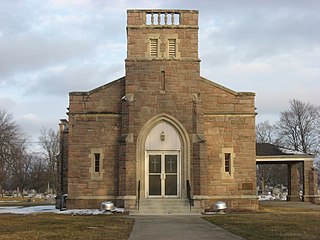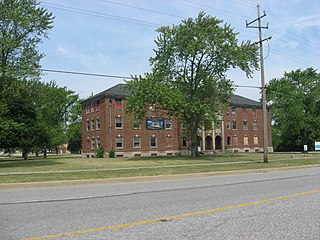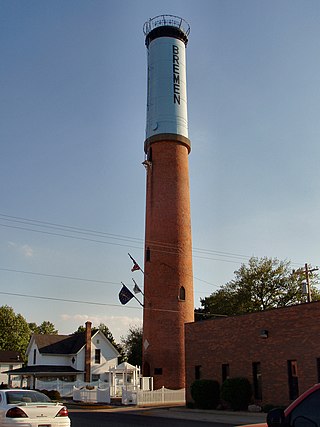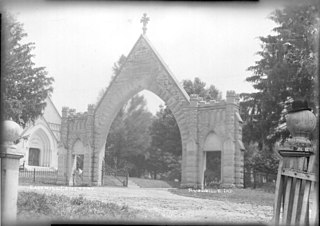
Crown Hill National Cemetery is a U.S. National Cemetery located in Indianapolis, Marion County, Indiana. It was established in 1866 on Section 10 within Crown Hill Cemetery, a privately owned cemetery on the city's northwest side. Administered by the United States Department of Veterans Affairs, the National Cemetery encompasses 1.4 acres (0.57 ha) and serves as a burial site for Union soldiers who fought in the American Civil War.

The Tippecanoe Twp. District No. 3 Schoolhouse and Cemetery is a place on the National Register of Historic Places in Tippecanoe, Indiana. It was placed on the Register on June 24, 2008. It includes the former schoolhouse of district 3, also known as the Summit Chapel School, that was built around 1860; a cemetery, established in 1844, and a 1930s outhouse built, presumably, by the Works Progress Administration. It is located on Tippecanoe's Summit Hill, the highest point in Marshall County, marking the southernmost point of a glacial advance. From the hill, the Tippecanoe River, one mile south, can be seen with a 270°view from the school. On the eastern edge is a hedge of osage-oranges.

Beech Grove Cemetery is a large historical cemetery and national historic district located at Muncie, Indiana. It was listed on the National Register of Historic Places in 1999.

The Big Run Baptist Church and Cemetery, also known as Franklin Township Historical Society, is a historic Baptist church and cemetery located at 6510 South Franklin Road in Franklin Township, Marion County, Indiana. The church was built in 1871 as a Baptist meeting house and served the church congregation until 1977. It is a one-story, gable front brick building with Italianate style design elements. The associated cemetery was established in 1854, with one stone dated to 1841. The most recent burial was in 1986. Also on the property is a contributing privy constructed about 1920. The Franklin Township Historical Society acquired the property and now uses the building as a historical museum.

Old Union Church and Cemetery is a historic church and cemetery located in Reeve Township, Daviess County, Indiana. The church was built in 1858, and is a one-story, Greek Revival style frame building. It is sheathed in clapboard and has a gable roof. It features a projecting entrance tower added about 1900. The adjacent cemetery contains about 1,000 burials; the earliest marked burial was in 1823. Also on the property are the contributing shelter house and privy.

Oak Hill Cemetery is a historic cemetery located at Lebanon, Boone County, Indiana. The cemetery was established in 1872 as Rodefer Cemetery, and includes many noteworthy examples of Victorian funerary art. Other notable features are the Late Gothic style William L. Powell Chapel (1930), office building (1955), English barn, the Romanesque Revival style main gate, north gate, the original mausoleum, Metzger Mausoleum, Heath Mausoleum, and Stokes Mausoleum. Notable burials include Indiana governor and U.S. Senator Samuel M. Ralston (1857–1925).

River View Cemetery is a historic rural cemetery located in Center Township, Dearborn County, Indiana. Designed by noted architect William Tinsley, the cemetery was established in 1869, and features curvilinear and contoured drive paths and radial burial arrangements. Notable contributing resources include the Soldier's Circle; entry gate, fencing, and signage; the cemetery chapel (1906); Romanesque Revival style well house (1889); and three mausoleums: the Yorm Mausoleum (1886), Stevens Mausoleum (1907), and McHenry Mausoleum (1877). Notable interments include Jesse Lynch Holman (1784–1842), Lonnie Mack (1941–2016), and William Steele Holman (1822–1897).

Bethel Church and Graveyard, also known as Bethel Community Church, is a historic church and cemetery in Logan Township, Fountain County, Indiana. The church was built in 1850 and is a one-story, simple Greek Revival-style timber-frame building. It measures 36 by 50 feet. It has a medium-pitched gable roof and sits on a sandstone block foundation coated in stucco. The congregation has been meeting on this site since 1825. The first marked burial in the adjacent cemetery dates to 1825.

Richsquare Friends Meetinghouse and Cemetery is an historic Quaker meeting house and cemetery located in Franklin Township, Henry County, Indiana. The meeting house was built in 1895, and is a one-story, brick building with a two-story Romanesque Revival style corner tower. A concrete block rear addition was built in 1955. It sits on a limestone foundation and has a steep gable roof. The adjacent cemetery was established in 1832 and remain an active burial ground with over 383 marked graves.

Lake County Tuberculosis Sanatorium, Nurses Home and Superintendent's House is a historic tuberculosis sanatorium located at Crown Point, Lake County, Indiana. The Nurses Home was built in 1930, and is a three-story, Georgian Revival style brick building on a raised concrete basement. It has a hipped roof with pediment. It features a three-bay projecting entrance portico with an arcade and variation of Corinthian order pilasters. The Superintendent's House was built in 1930, and is a 2+1⁄2-story, Colonial Revival style brick building with a one-story flat roofed wing. The Lake County Tuberculosis Sanatorium closed around 1971.

Jacoby Church and Cemetery is a historic community church and cemetery located in Center Township, Marshall County, Indiana. The church was built in 1860, and is a one-story, Greek Revival style frame building, measuring 32 feet by 40 feet. The front facade features a projecting bell tower / vestibule added in 1910. The cemetery was established in 1850, and contains approximately 166 burials.

Bremen Water Tower, also known as Bremen Water Works Standpipe, is a historic water tower located at Bremen, Marshall County, Indiana. It was built in 1892, and consists of a 68 foot tall brick base with Second Gothic Revival style design elements topped by a 36 foot tall tank. The base sits on a limestone foundation and is 13 feet in diameter. It was taken out of commission in 1955. It remains a community icon and was named an American Historic Water Landmark in 1975.

Newberry Friends Meeting House, now the Friends of Jesus Fellowship Friends Church, is a historic Quaker meeting house and cemetery located in Paoli Township, Orange County, Indiana. It was built in 1856, and is a one-story, rectangular, vernacular Greek Revival style frame building. It sits on a rubble limestone foundation and is sheathed in clapboard siding. The adjacent cemetery was established in 1818, and the earliest marked burials date to the 1840s. The congregation played a significant role in the settlement of African Americans in Orange County.

Charles S. and Mary McGill House is a historic home located at Valparaiso, Porter County, Indiana. It was built in 1926, and is a two-story, Z-shaped Tudor Revival style brick dwelling. It has a steeply pitched cross-hipped roof and features stuccoed areas with half-timbering and massive chimneys.

Brick Chapel United Methodist Church, also known as Montgomery Chapel, is a historic Methodist church located in Monroe Township, Putnam County, Indiana. The church was built in 1872, and extensively remodeled in 1912 in the Renaissance Revival style. A Sunday School addition was built in 1956. It features a large stained glass window, recessed arches, and an entrance tower. Also on the property is the contributing church cemetery established in 1839, with over 2,000 burials.

East Hill Cemetery is a historic cemetery and national historic district located in Rushville Township, Rush County, Indiana. The cemetery was established in 1859 and contains about 14,000 burials. Among the contributing resources are the Gothic Revival entrance arch, a public mausoleum (1935), Payne family mausoleum, Logan family mausoleum, Wilkison crypt, Havens monument, Willkie Memorial designed by sculptor Malvina Hoffman (1885–1966), and the Civil War Monument. The cemetery features numerous examples of high Victorian gravestone art featuring statuary and reliefs. Among the notable burials is Republican presidential candidate Wendell Willkie (1892–1944).

Hopewell Methodist Episcopal Church and Cemetery is a historic Methodist Episcopal church and cemetery located in Lagro Township, Wabash County, Indiana, US. It was built in 1872 and is a one-room Gothic Revival style brick church. It has a front gable roof and features a bell tower and pointed arched windows. Also on the property is the contributing cemetery, which accepted its first burial in 1849, and the church's 19th century bell.

The Sylvania is a historic apartment building located at Indianapolis, Indiana. It was built in 1906, and consists of two three-story, detached glazed brick and grey limestone buildings. It features Renaissance Revival style door and window surrounds and Classical Revival style design elements.

Horner–Terrill House is a historic home located at Indianapolis, Indiana. It was built about 1875, and is a 2+1⁄2-story, roughly L-shaped, Second Empire style brick dwelling with limestone detailing. It features a three-story tower, mansard roof, and round arched openings. Also on the property is a contributing garage. It was listed on the National Register of Historic Places in 2013.

Indianapolis Fire Headquarters and Municipal Garage is a historic fire station and garage located at Indianapolis, Indiana. The Fire Headquarters was built in 1913 for the Indianapolis Fire Department, and is a three-story, Classical Revival style orange-brown glazed brick building with limestone detailing. It sits on a concrete foundation and has a square brick parapet. The Classical Revival style Municipal Garage was built in 1913, and expanded in 1925 with two Tudor Revival style additions.
























